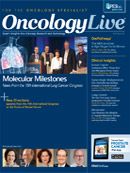Publication
Article
Everolimus Plus Tamoxifen Delivers Benefits in Hormone-Resistant mBC
Author(s):
Combining tamoxifen with everolimus increased the clinical benefit rate, time to progression, and overall survival versus tamoxifen alone in postmenopausal women with metastatic breast cancer.
Combining tamoxifen with everolimus (Afinitor) increased the clinical benefit rate (CBR), time to progression (TTP), and overall survival versus tamoxifen alone in postmenopausal women with metastatic breast cancer (mBC) resistant to endocrine therapy, according to data from the phase II TAMRAD study. The results also showed that the benefit of the combination treatment was especially pronounced in patients with secondary hormone resistance.
Thomas Bachelot, MD, PhD, director of the Breast Cancer Unit at the Centre Léon Bérard in Lyon, France, and associates randomized 111 postmenopausal women to a daily regimen of tamoxifen (20 mg) plus everolimus (10 mg), or tamoxifen alone (20 mg). Study participants had hormone receptor—positive, HER2-negative mBC that was resistant to aromatase inhibitors (AIs).
Because the biologic mechanisms that underlie primary and secondary hormone resistance may not be the same, subjects were stratified by primary and secondary resistance. Primary resistance was defined as relapse during or ≤6 months after completion of adjuvant AI treatment or progression in the metastatic setting ≤6 months following the start of AI treatment. Patients with secondary resistance had relapsed either >6 months after adjuvant AI therapy or after they had been responding to AI therapy in the metastatic setting for ≥ 6 months.
Hormone resistance in mBC is probably partially explained by “cross-talk” between signal transduction pathways, the researchers explained. The potent oral mTOR inhibitor everolimus has been shown to restore the sensitivity of endocrine-resistant breast cancer cells to endocrine therapy, and has also shown anticancer activity in early-phase mBC clinical studies.
The primary efficacy endpoint of the TAMRAD study was the six-month CBR, defined as the percentage of all patients with a complete or partial response or stable disease at six months. The six-month CBR rates were 61% (95% CI, 47%-74%) in the tamoxifen plus everolimus group versus 42% (95% CI, 29%-56%) in patients receiving tamoxifen alone.
The median TTP was 8.6 months (95% CI, 5.9-13.9) and 4.5 months (95% CI, 3.6-8.7) in the combination arm and tamoxifen-alone group, respectively, (exploratory P = .002), which corresponded to a 46% reduction in the risk of progression (HR = 0.54; 95% CI, 0.36-0.81).
The analysis also revealed a 55% reduction in the risk of death associated with combination therapy (HR = 0.45; 95% CI, 0.24-0.81; exploratory P = .007).
Patients with secondary hormone resistance benefited more from combination therapy than patients with primary hormone resistance. Of patients with secondary resistance, the CBR was 74% with tamoxifen plus everolimus and 48% with tamoxifen alone. The corresponding percentages were 46% and 36% in patients with primary resistance.
The toxicities associated with combination therapy were consistent with those previously reported for tamoxifen and everolimus and included primarily fatigue, stomatitis, rash, anorexia, and diarrhea. Most were of grade 1 or 2 severity and could be managed without the need to stop everolimus treatment.
Bachelot et al said their results suggest that the combination of tamoxifen and everolimus may reverse hormone resistance in postmenopausal women with mBC resistant to AIs. Many earlier studies targeting pathways that are believed to help promote AI resistance have been unable to show consistent efficacy in estrogen receptor—positive, HER2-negative mBC.
Bachelot T, Bourgier C, Cropet C, et al. Randomized phase II trial of everolimus in combination with tamoxifen in patients with hormone receptor— positive, human epidermal growth factor receptor 2–negative metastatic breast cancer with prior exposure to aromatase inhibitors: a GINECO study. J Clin Oncol. 2012;30(22):2718-2724.










